In Defense of Tech Trees
They're a good form of 2D history; also I think we should build the master tree! 🌳

Trees serve as a powerful metaphor for various phenomena, especially those that unfold across time. Evolution can be represented as a phylogenetic tree, where the root is a common ancestor and the branches and leaves are its descendants. Conversely, if you consider a given person as the root and their ancestor lineages as the branches, you get a genealogical tree.
(If the roots are instead being gnawed on by Níðhöggr, the horrific dragon that eats the corpses of the people sent to hell, then you might be dealing with Yggdrasil, the world tree of Norse mythology that supports the earth and the heavens.)
Yet another type of metaphorical tree is the technology tree, or tech tree. This one comes from games, specifically the Civilization ones, both the original 1980 board game and the 1990s-to-today computer games. I wrote about them in an old post, in which I argued that they were a good tool to visualize technological progress and get a better appreciation for it:
Tech trees are very much a game concept, as the Wikipedia article about them makes clear. Their point is to discretize progress into a way that is both functional and fun within the simplified strategy game environment. To get to a specific tech (say, rockets) you need prerequisites (say, airplanes or artillery). These prerequisites are well defined, though there can be alternative paths available. The point is to consistently reward players with the unlocking of a new tech — frequent rewards are a fundamental reason that games are fun.
The idea of tech trees is appealing, so sometimes people draw inspiration from it to create real-life tech trees. Balaji Srinivasan suggested that in 2021, saying that they could be the next innovation in presenting ideas to investors. The Foresight Institute, a research non-profit, has been developing tech trees in five technological areas with the goal of understanding and organizing future progress. They made highly detailed trees for nanotechnology, neurotechnology, intelligent cooperation, space, and longevity.
As far as I know, that’s it. Tech trees haven’t become particularly widespread since 2021. It’s also unclear whether the trees created by the Foresight Institute produced anything useful at all.
The reason might be that tech trees are very much a game concept. They serve a purpose in strategy games, but they’re not actually a good model of how technology develops. We never really know the prereqs. Innovation is too unpredictable, too serendipitous. A real-life tech tree might end up being obsolete next year, when an innovation that no one has foreseen appears. And there might be predicted future technologies on the tree that will never be attained, because they are not actually possible.
Not to mention that historically, some technologies (like the printing press in Asia and Europe) were discovered in different parts of the worlds following very different paths. Tech trees are deterministic, but technology isn’t.
Such issues lead some people to claim that tech trees are a useless concept. Or worse, a harmful one, causing people to learn a bad model of how technology works.
I want to defend tech trees a bit. I intuitively agree with Noah Smith that “having a complete innovation map for human technological history (i.e., a real tech tree) would actually speed innovation,” though that’s more a feeling than a strongly held position.
Let’s go through a few reasons why tech trees might be useful in real life, despite everything above.
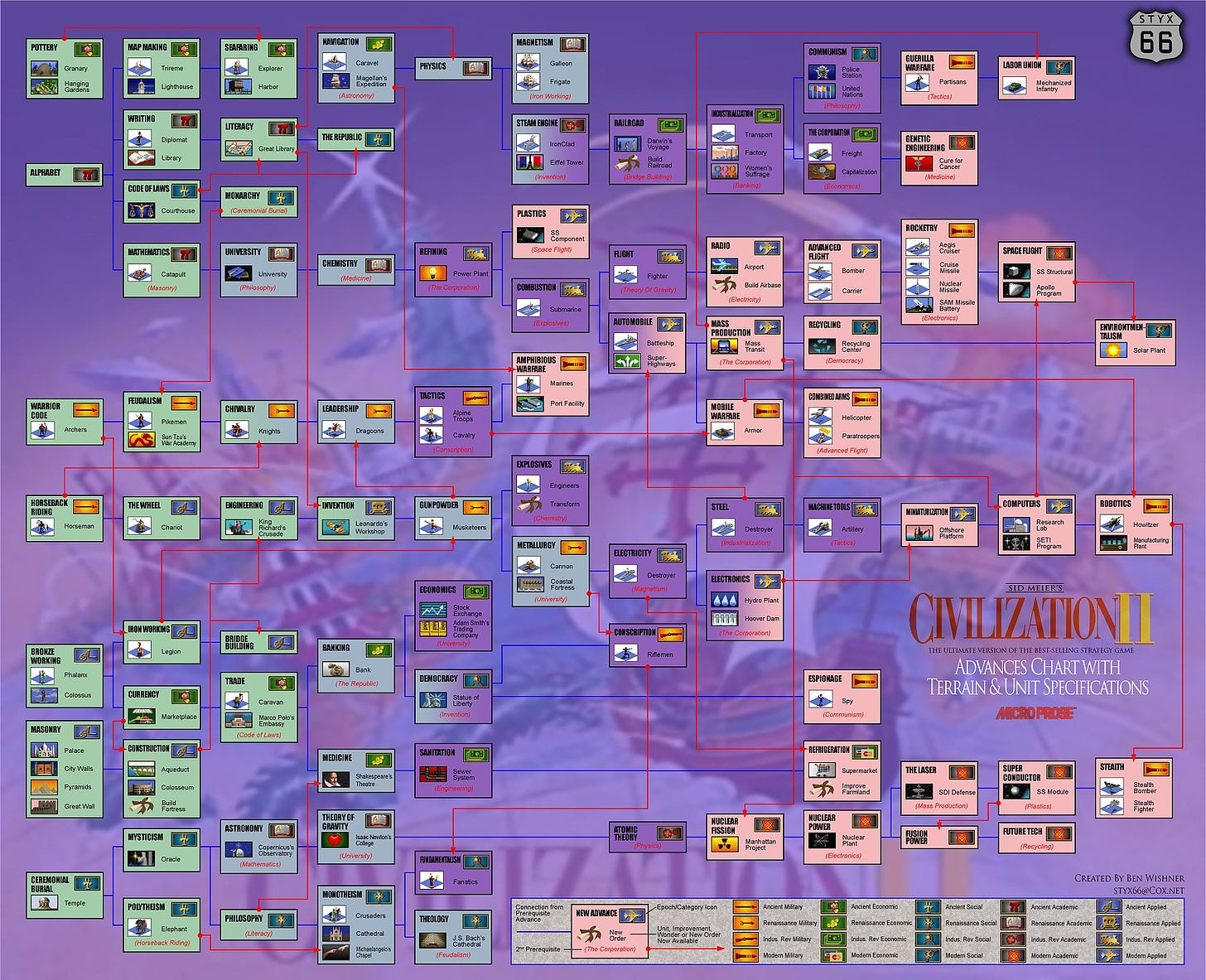
1. Innovation is complicated, so any decent model can help
I don’t think anyone truly understands technological innovation. Or, for that matter, any creative process, like art and writing and philosophy. It’s always a bit of a mystery how people manage to invent new things and ideas. It’s mysterious even to the innovators themselves.
The main way we make sense of innovation and creativity is through anecdotes — stories like how Alexander Fleming accidentally discovered penicillin. These are great, but to get anything like an understanding of the mysterious alchemy of innovation, you need to read a lot of them, with no guarantee that you’ll find out what’s important.
The counterweight to anecdotes is summary statistics. There’s no time to read the biographies of a hundred Nobel Prize winners, but you can, say, look at the average age at which their Prize-worthy discoveries were made, and learn something useful. The answer, it turns out, is 44.1±9.7 years, according to Bjørk 2019. A model of innovation that simply said “innovation happens when inventors are 44 years old on average” wouldn’t be very useful, but it’s a start. Add some more (correct) data, and you can start to make sense of the ways human manage to come up with new stuff.
2. Game tech trees are a good enough model, to a first approximation
Considering how difficult it is to understand innovation, I contend that tech trees are actually pretty good models. They have a few nice properties:
They show the order in which technologies were invented, through prerequisites. It’s useful to know how the scientific discovery of electricity allowed the invention of the telegraph and therefore long-distance telecommunication.
They often show the time dimension, allowing us to see which tech were developed roughly at the same time. For example, banks and gunpowder, or nuclear fission and television.
They feature branching, showing that tech can take several alternate paths at certain points. For example, a well-made tech tree would allow the development of a large administrative state without having first developed writing, as the Inca Empire did, unlike other complex societies.
They simplify tech into discrete, abstract units. For example, there were thousands of small innovations involved in inventing the automobile, but most game tech trees just have a single box labeled “Automobile” which you discover in an instant after having invested research into it. I think this is fine — technology is actually relatively discrete. Humans do think in terms of projects that are either completed or not. The true discrete unit is much smaller than “the automobile” (it’s things like the four-stroke engine and a thousand other small inventions, and also specific models of automobiles like the Benz Patent-Motorwagen), but the discretization involved in tech trees is not a bad thing to learn.
Opponents of tech trees will counter that tech trees have some undesirable properties — like determinism and exaggerated focus on technology as the driving force of history. Do those mean that tech trees are a bad model?
3. Tech trees aren’t required to be deterministic
As I alluded to earlier, the top criticism levied against tech trees is that they’re deterministic. Sure, maybe there are a couple of alternate paths here and there, but overall they presuppose that innovation happens in a predictable pattern which you can just follow.
That’s true, but I’d say it’s mostly an artifact of their use in games. You have to present a path (or a small number of paths) to the player, otherwise the game won’t work. Open-ended innovation can’t really be made into something you play.
Since a path has to be implemented, might as well make it the historical path. We can’t know whether long-distance communication would have been possible without electricity, so a game might as well assume electricity is a prereq. However, take a tech tree out of a game environment, and you’re free to model paths that are as complex as you like.
In real life, computers took off after the development of electronics, but we know that mechanical computers were attempted starting with Charles Babbage in the 1830s and 40s. A flexible tech tree could have both possibilities — and perhaps others, if we can think of something plausible, though that’s of course difficult to do and generally belongs to the genre of science fiction.

4. Tech trees don’t have to be just about tech
Another criticism is that tech trees focus too much on technology — that there are countless other factors that lead to technological breakthroughs besides previous tech. This is kind of a weird point to make against game tech trees, though, since they typically involve far more than just hard tech. Civilization games have many religious, philosophical, social, and artistic innovations as discrete “technologies.”
An innovation can be anything: a new way of combining existing things, a decision to abandon a previous research direction, an attempt at reproducing a scarce material that is sourced from abroad… These are all fair game to be included in a tech tree, if you zoom in enough. (Which games typically don’t, for game reasons.)
And besides, if you want to focus on other stuff than technology, that’s fine — just use some other model of history. If we’re looking at tech, then by necessity we’re simplifying away many non-tech elements. History, otherwise, is just too big.
5. Strictly speaking, Tech trees aren’t actually trees
In math and computer science, a tree is a structure that starts from a root and branches out any number of times. Importantly, the branches never meet. Otherwise it’s some other kind of graph.

Tech trees are not that. The branches meet all the time. There’s not necessarily a single root. So in practice, tech trees are tech nets, or tech graphs — which also means they’re much more flexible than it may seem at first glance. There’s really nothing preventing a single tech to open up dozen of potential innovations, or conversely, that a single tech materializes as the outcome of a hundred different prerequisites.
(Incidentally, phylogenetic and genealogical trees are also not strictly trees, though the metaphor works far better for them. Phylogenetic tree branches can meet due to horizontal transfer of genetic material, as in bacteria; genealogical tree branches meet once you go far enough back in time that each of your ancestors show up in multiple spots.)
(I don’t know whether Yggdrasil is a tree in the math sense. My guess is yes. Someone should ask Dáinn, Dvalinn, Duneyrr, and Duraþrór, the four stags who eat among the foliage of the branches, and whose antlers, catching dew, are the source of the rivers of the world.)
6. Tech trees are ultimately a tool for historical analysis, not prediction
Notice that almost everything we’ve been discussing is about past tech, not future tech. This is because tech trees can be built with any sort of confidence only in hindsight.
In other words, tech trees primarily as a form of 2D history, a way to summarize the history of the world along both time and space. This is extremely difficult to do and always lossy. I explored the idea in this essay, which I think is still one of my best:
Of course, tech trees are less useful for people like Balaji and the Foresight Institute if they can’t be used to predict the future. I think a lot of the criticism ultimately stems from that: it seems hubristic to use a concept from a game to divine something as important as technological innovation!
But that’s a fully general counterargument against all of history. One could say that whatever mental models we learn from history are always overfitted to the actual history, and have low predictive power. But that doesn’t mean learning history is useless! For one thing, that’s all the data we have, so we don’t really have a choice. For another, it’s not zero predictive power, either. It is actually useful to learn the prerequisites of the British steam engine, and to understand why the Hellenistic Greek steam engine never took off — that can help us realize that some toy inventions from today might become extremely useful in the future, unbeknownst to us.
The natural next step, after having pondered tech trees for an entire essay, would be to build one. I can hardly think of cooler projects than trying to build the real-life, full historical tech tree, with a high level of detail. In fact I wanted to get started on it before publishing this post, but I’m still stuck at the level of “what software should I use?”
Not that I would have gotten very far in any case. Building the true tech tree is an enormously challenging task. I expect that the end result would have a similar level of complexity to this chart of metabolic pathways:
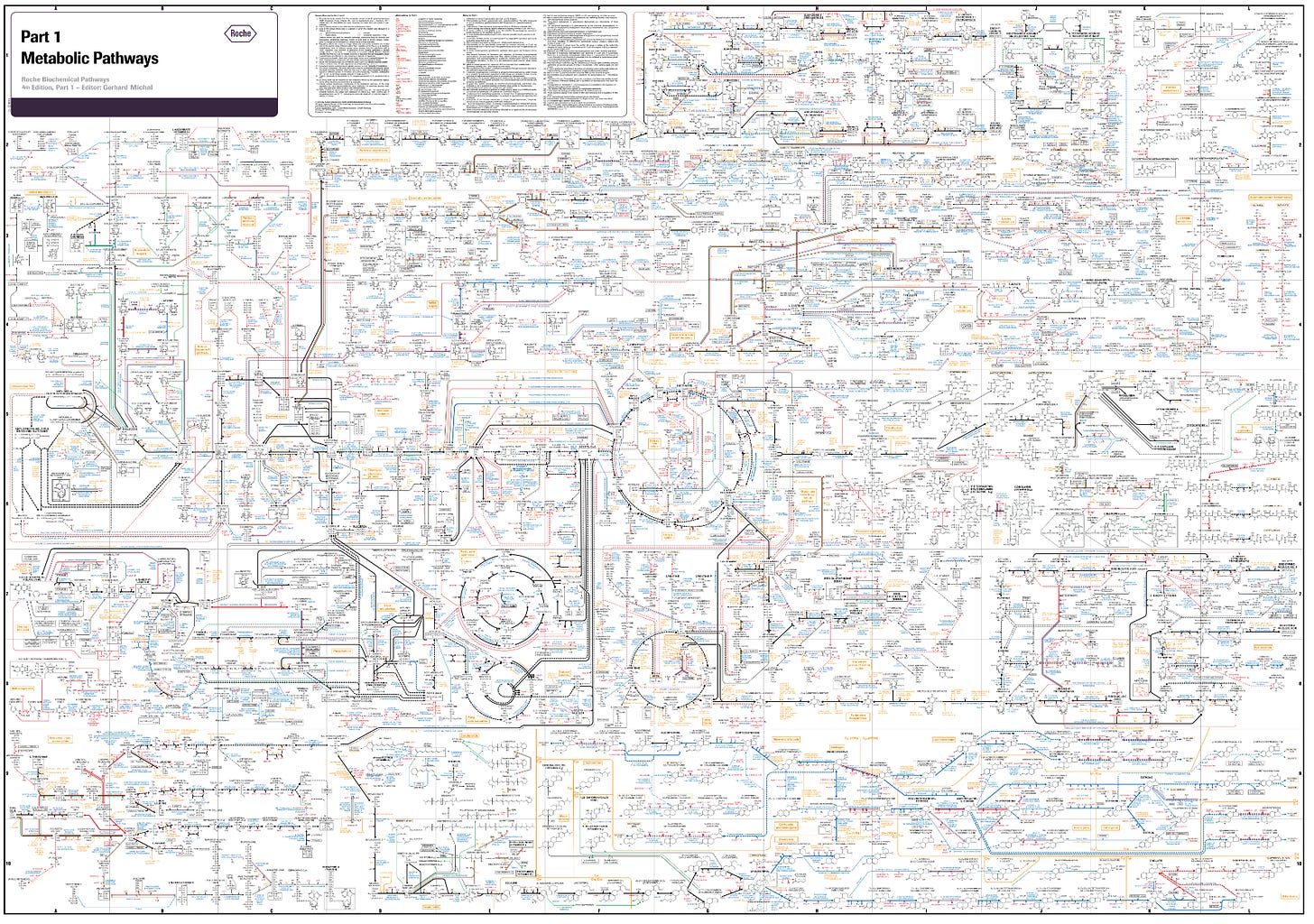
I would start with something like the Wikipedia timeline of historic inventions, and then get some passionate people to gradually fill each of the many many subtrees. One of the specific challenges would be to figure out the most useful level of abstraction. It’s probably not useful to include each new macOS version as a separate entry, or even macOS itself — probably that “operating systems” is sufficient, or maybe “UNIX operating systems” alongside a few others. The chart below, about the oral contraceptive, is probably a bit too detailed, but having a few of its nodes would be a potentially good tiny subsection of the tree. Or should it just be simplified into “the oral contraceptive”? I don’t know.
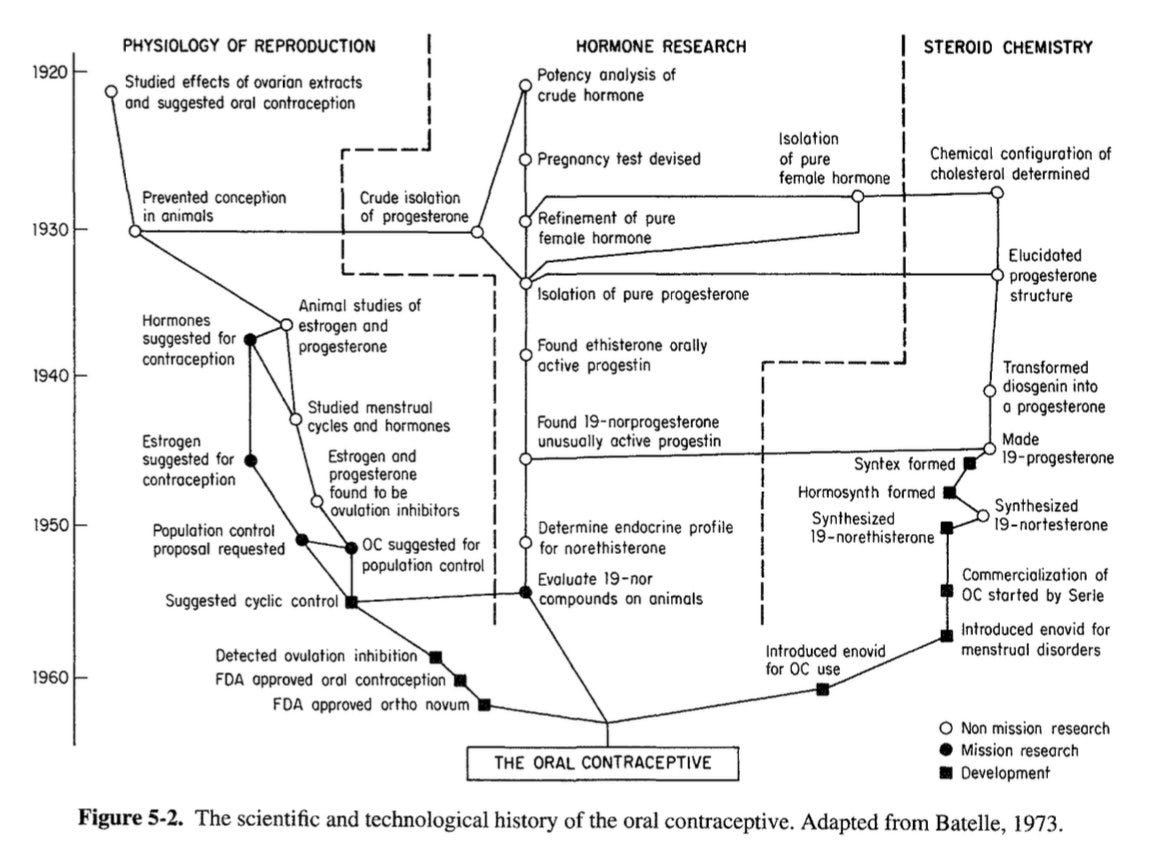
There’d be other challenges, like how to deal with technologies that were independently invented in different places and times, or inventions that were lost (although that rarely happens!). But if it were a collaborative project, I feel like we could get somewhere within a few months or years.
And then we’d be able to glance at the majesty of human progress, hopefully inspiring others to grow the tips of its branches, whatever form that takes.






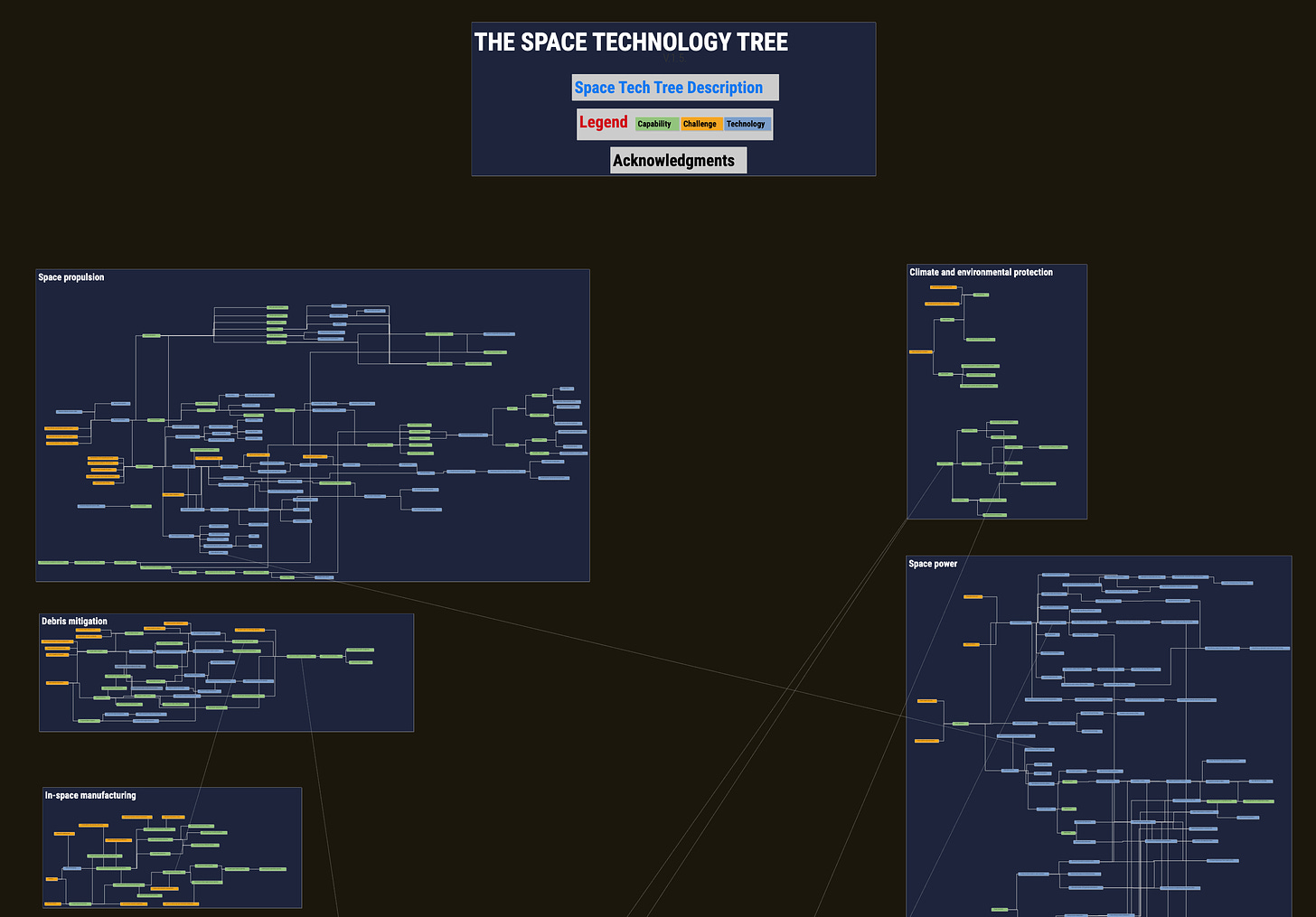


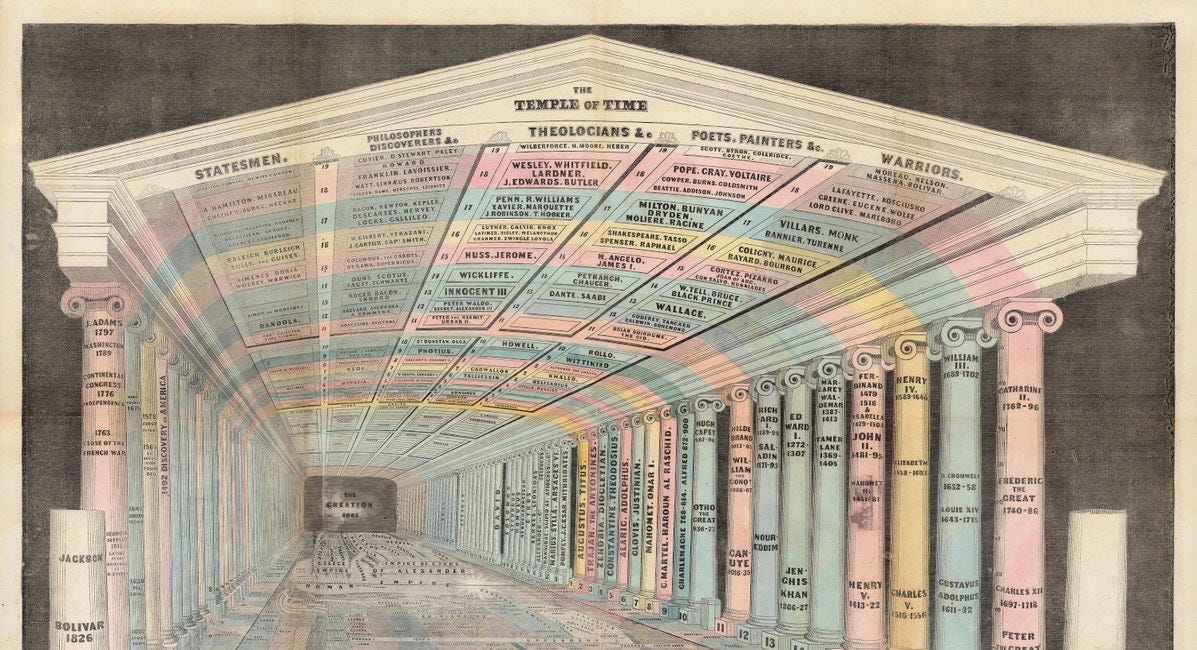



Tim Hwang is organizing a symposium on tech trees! You should come.
https://twitter.com/timhwang/status/1692625535866724690?s=20
I would imagine that James Rosen-Birch would be delighted to have served as the inspiration for your thinking and writing. Inspiring careful thought and response is way more important to most thinkers than just inspiring “agreement.” After all, disagreement opens up way more opportunities for further development and refinement of any idea than does mere shallow agreement. I enjoyed your article very much.